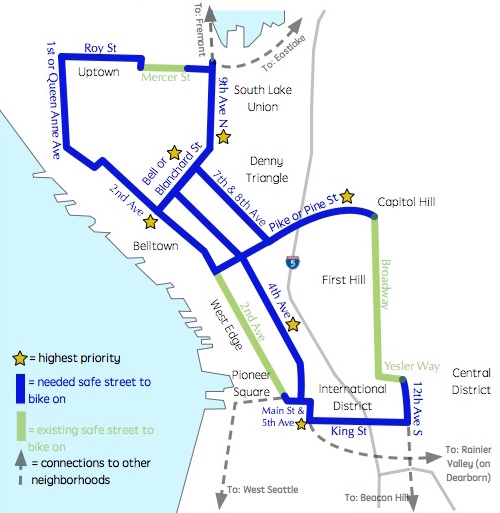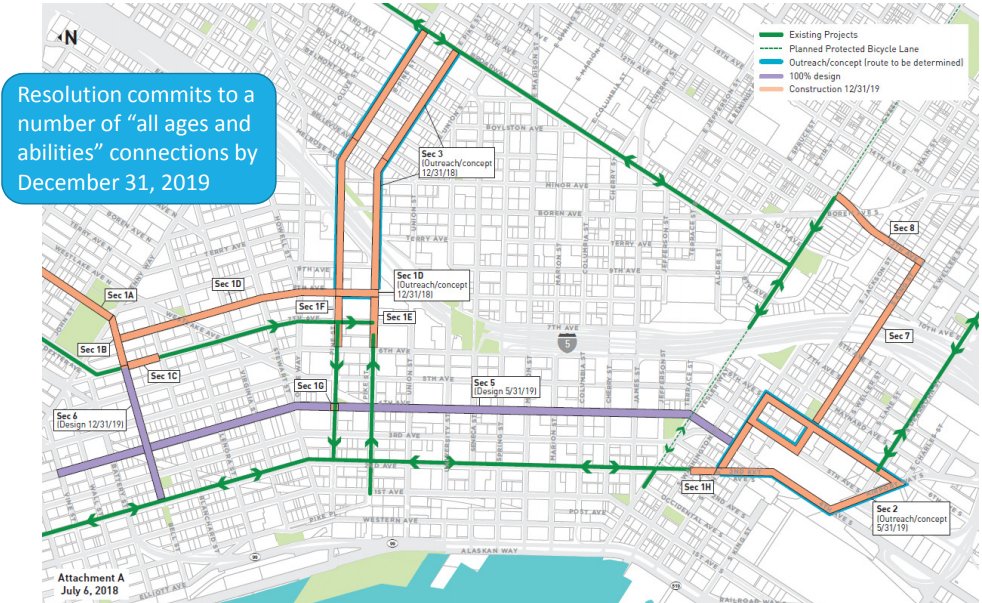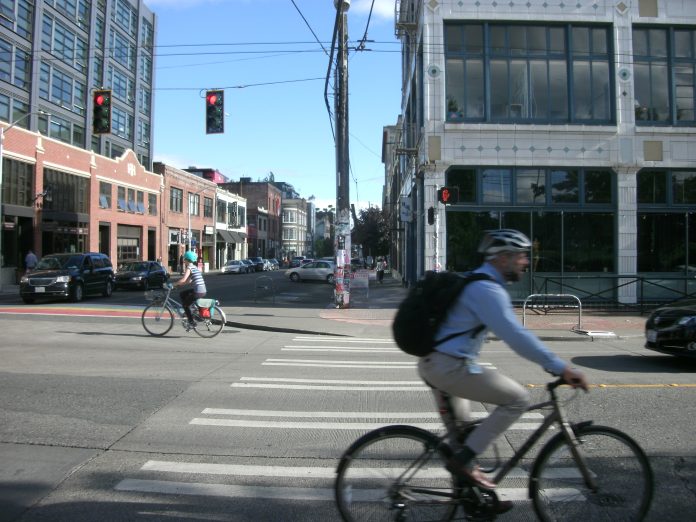After delays and setbacks in recent years held Seattle back from having a fully connected network of safe bicycle facilities downtown, the Seattle City Council is preparing to pass a resolution laying out exactly what segments of should be constructed to complete the network and when they should be complete. The resolution, which is not legally binding, unanimously passed the Transportation and Sustainability Committee during a special meeting last Wednesday that five councilmembers attended–enough to pass the motion in full council.
Councilmembers Sally Bagshaw and Lorena González–not regular members of the Transportation and Sustainability committee–joined chair Mike O’Brien, Rob Johnson and Kshama Sawant in voicing support for completing the “basic bike network,” an idea created by advocacy organizations Seattle Neighborhood Greenways and Cascade Bicycle Club. The proposal was to create a minimum grid that people of all ages and abilities (a term that appears multiple times in the resolution) would feel safe biking on. Cities like Edmonton, Canada and Seville, Spain have seen their rates of people biking skyrocket after the installation of minimum grids.

The date of December 31, 2019 is the biggest red-letter date in the resolution, which was introduced by Councilmember O’Brien. By that time, the following connections are to have been completed (all of these connections below are in the form of protected bike lanes unless otherwise noted):
- 9th Ave N in South Lake Union between Harrison Street and Denny Way;
- Bell Street between Denny Way and 7th Avenue;
- 7th Ave between Bell and Blanchard, connecting to the newly completed 7th Avenue one-way southbound bike lane;
- 8th Avenue between Bell and Pine Street, one way northbound:
- Pike Street from 6th Avenue to 8th Avenue, extending the one way lane:
- Pine Street from 8th Avenue to 7th Avenue, extending the one way lane;
- 2nd Ave Ext S from S Washington St, the current terminus of the 2nd Ave bike lane, to S Main St;
- An all-ages connection between S Main St and the S Dearborn St protected bike lanes on a route that is yet to be determined;
- Pike or Pine Street from Bellevue Avenue to Broadway;
- An interim facility on Pike Street and Pine Street from Bellevue Ave to 8th Avenue, during the period that the Washington State Convention Center expansion project is occurring;
- S King St from 5th Ave S to 12th Ave S, in the form of neighborhood greenway; and
- 12th Ave S from Yesler Way to S King St.
The resolution also calls for design work to be completed on several other center city bike projects. It calls for the city to be at 100% design on the 4th Avenue bike lane (currently set to be constructed in 2021) by next May, and at 100% on protected bike lanes on Bell Street by the end of next year. The resolution also calls for additional traffic calming on the “Bell Street Park” segment of the route between 2nd Avenue and 5th Avenue.

Many of these timelines are ones that the Seattle Department of Transportation (SDOT) has already committed to. But will it be able to deliver on everything? Darby Watson, SDOT’s acting Chief of Staff and who has been deeply involved in the bicycle program at the department in previous roles, did not want to commit to saying that they were up to the task at last week’s committee meeting. But Councilmember O’Brien, in a press conference prior to the committee meeting, stated that the project list in the resolution was developed in concert with SDOT and advocacy groups with the intention of not putting anything in the resolution that is not achievable.
The city council getting directly involved in specific bicycle master plan projects is a signal that they aren’t happy with the progress being made at SDOT: key mobility projects are frequently slipping months behind schedule. But cost is going to be a major issue for the oversight of the bicycle master plan program: we reported in May that the initial report on expenditure of Move Seattle funds for bike projects showed that we have spent around 25% of the money earmarked over the 9 years of the levy, but only built around 10% of the miles called for. Building lanes downtown where there are likely to be many complicated intersection treatments needed means that the project costs are not likely to go down any time soon. However, the Washington State Convention Center expansion will be providing $16 million for bike lanes on Pike Street, Pine Street, and on 8th Avenue as part of its public benefits agreement.
The resolution also includes language that asks SDOT to update its Traffic Control Manual to address how bike lane closures around construction zones are handled, to ensure that once an all ages and abilities network is constructed, it can’t easily be closed for construction without a detour that meets the same standards.
The full council will consider and likely pass the resolution on Monday, with possible amendments around how the council receives information on progress unlikely to change the specific projects outlined in the resolution.
Ryan Packer has been writing for The Urbanist since 2015, and currently reports full-time as Contributing Editor. Their beats are transportation, land use, public space, traffic safety, and obscure community meetings. Packer has also reported for other regional outlets including BikePortland, Seattle Met, and PubliCola. They live in the Capitol Hill neighborhood of Seattle.


